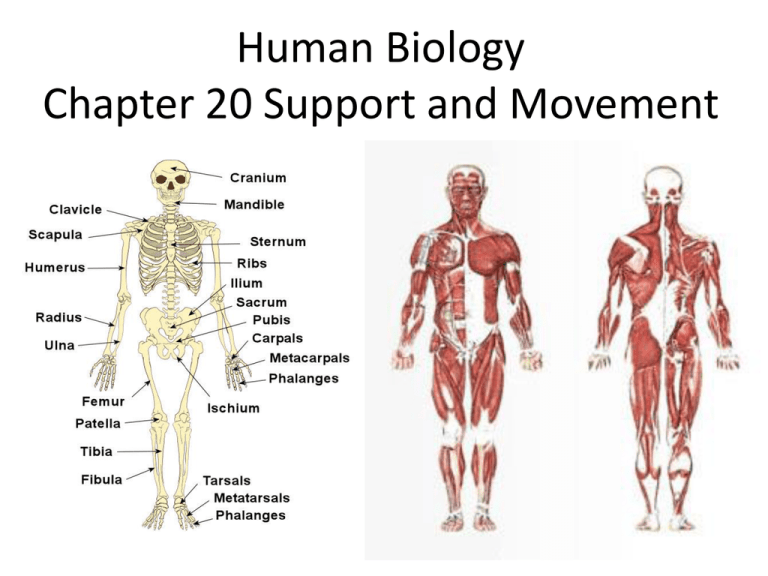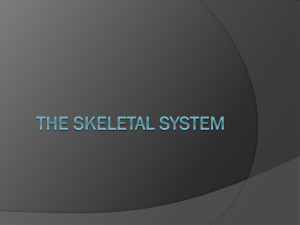PowerPoint Presentation - Human Biology Chapter 20 Support and
advertisement

Human Biology Chapter 20 Support and Movement Introduction: • Have you ever seen a house or a skyscraper being built? • What is the function of the metal or wooden frame of the building? – It supports the walls and roof of the building • As humans we have a frame, which is our Skeletal system. – Just like a frame inside a building, our skeleton is inside our body which is called an endoskeleton (internal skeleton) What organisms can you name that have an exoskeleton? The Skeletal System • Your skeletal system is made mostly of bone. • Bone is a very hard tissue, which is also a little flexible. • Your skeleton also contains cartilage, which is tough, flexible tissue. – Examples: ears & end of your nose • The ends of some bone contain cartilage, which protects the ends of bone from rubbing against each other. The Skeletal System cont. • Human skeleton is divided into 2 main parts: – Axial skeleton: skull, rib cage, backbone – Appendicular skeleton: shoulder, hip, pelvis, arms, legs What are the functions of your skeletal system? • Supports your body and gives it shape • Covers and protects certain body organs • Many bones of the skeleton work with muscles to make movement possible • Some bones make blood cells • Bones store minerals such as calcium and phosphorus that the body needs Bones • Your body has 206 bones. • Bones range in various sizes. – Example: some are long, short, and flat • The three bones in your ear (incus, stapes, malleus) are the smallest bones in the body. • The largest bone is the femur (thigh bone). Structure of Bones • Bones are unusual because they are made up of living and non-living material. • A bone is covered with a thin, tough membrane called the periosteum. – The periosteum has many blood vessels that supply bone cells with blood. Structure of Bones cont. • The hardest part of the bone is called the compact bone, which is made up of living bone cells, tough protein fibers, and mineral deposits. – Calcium is the mineral that makes bone hard and gives bone its strength. Structure of Bones cont. • The ends of bones are made up of spongy bone, which have many spaces like a sponge. – Its structure adds strength to bone without adding much weight. Structure of Bones cont. • The space in the spongy bone are filled with bone marrow, which is a soft tissue. – New blood cells are made in red marrow which can be found in spongy bone. – The center, or shaft, of long bones contain yellow marrow, which is made mostly of fat cells. Joints • Movement can only occur where bones meet. • The place where 2 or more bones meet is called a joint. • What holds your bones together? – Ligaments: bands of tough tissue • What happens to your ligament when you get a sprained ankle or finger? – Ligaments connected to that bone stretch too far Types of Joints • • • • Hinge Joint Ball-and-Socket Joint Pivotal Joint Gliding Joint Hinge Joints • A hinge joint allows bones to move backward and forward in only one direction. – Example: knee and elbow Ball-and-Socket Joints • Ball-and-socket joints permits movement in all directions, which allows the widest range of movement of any kind of joint. – Example: hip and shoulder Pivotal Joints • Pivotal joint allows both side-to-side and up-anddown movements. – Example: place where the skull joins the 1st vertebra Gliding Joints • Gliding Joint allows some movement in all directions, where by the bones slide along each other. – Examples: wrist, ankle, vertebrae








